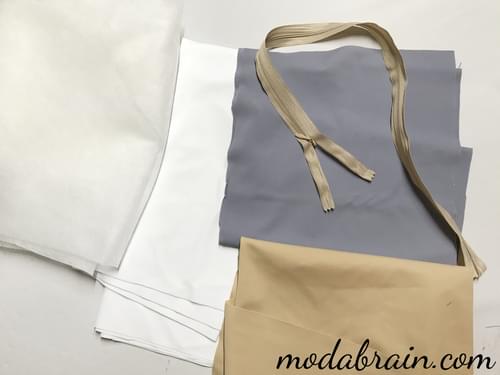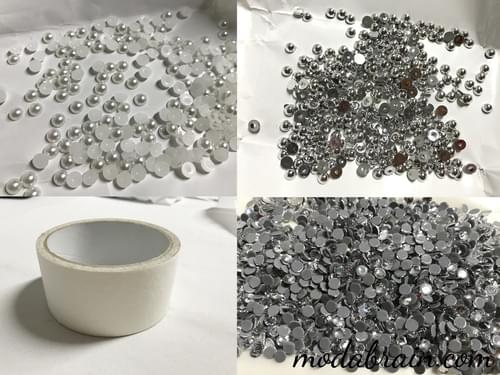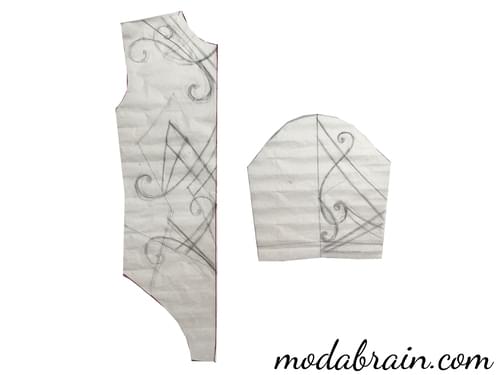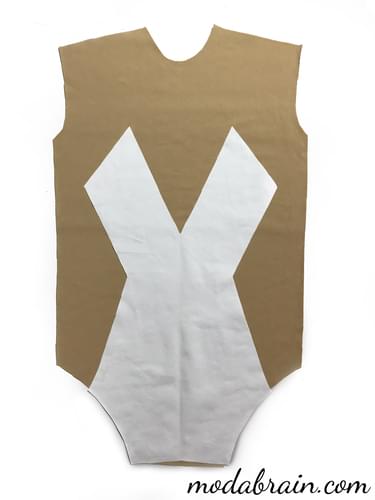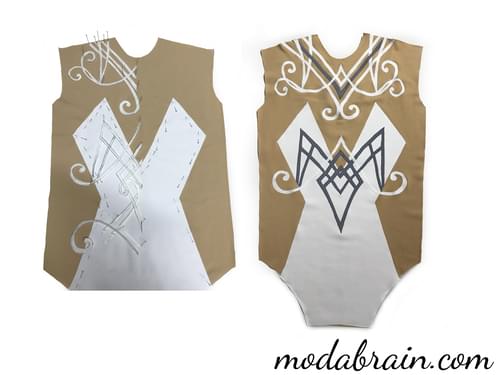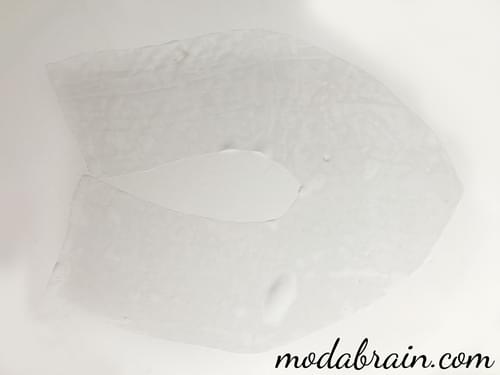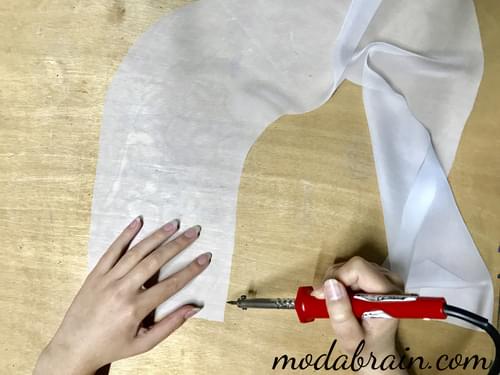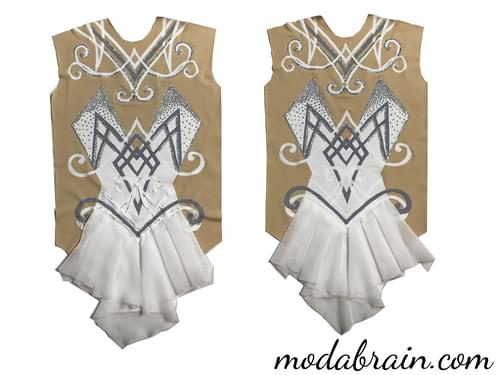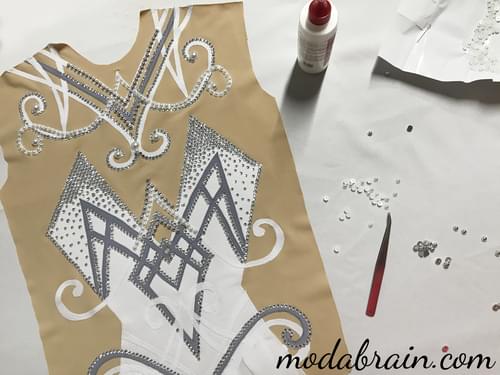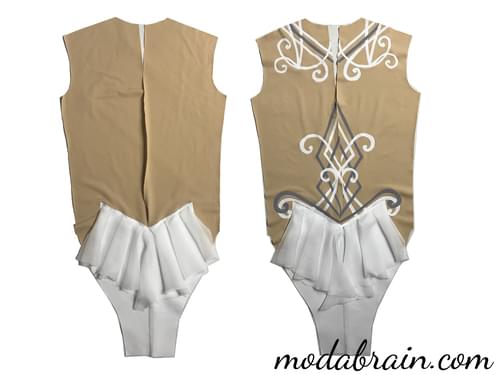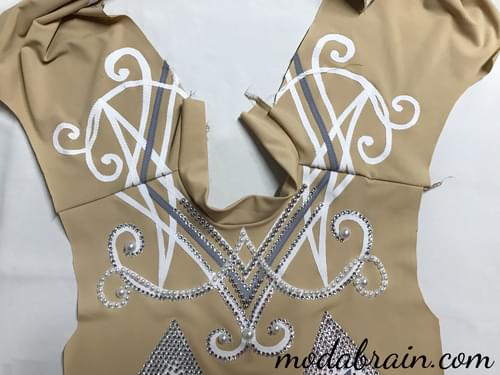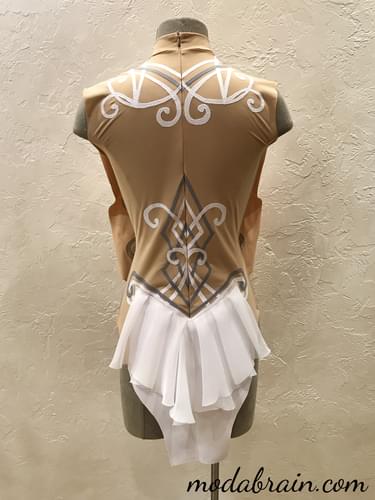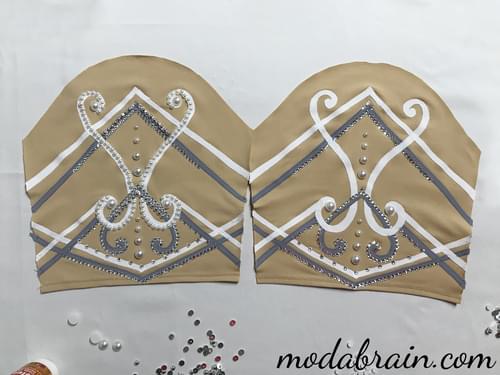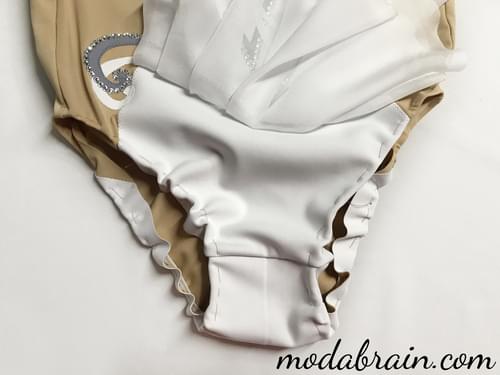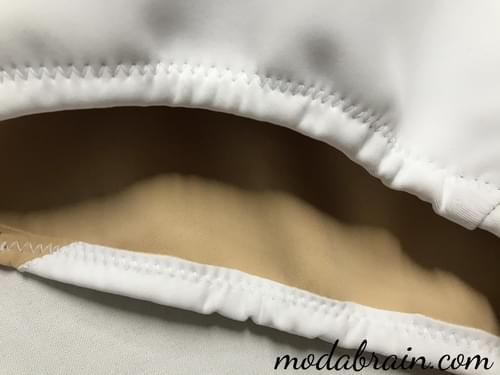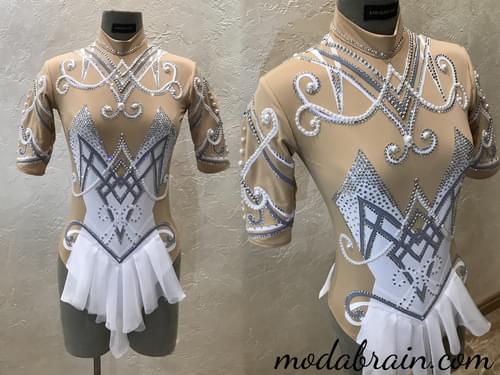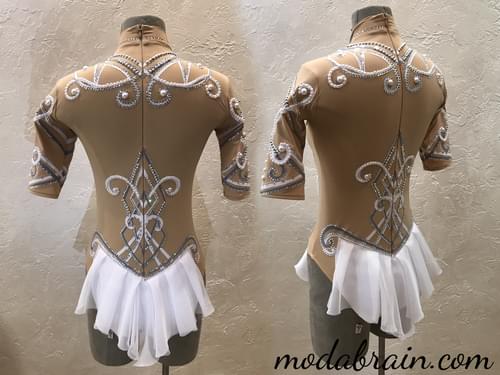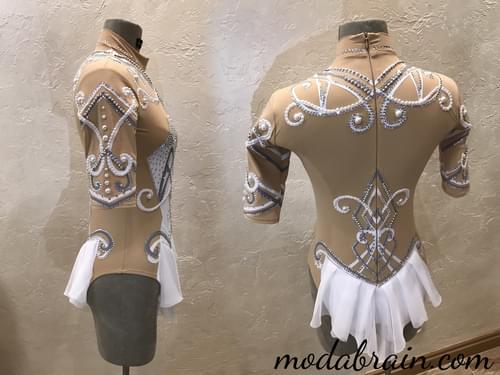
In this article, you will see the step-by-step process of creating a delicate and airy white leotard, which I sewed for the circus aerial gymnast Daniela from Lithuania.
Content
- The difference between swimsuits for circus and rhythmic gymnastics
- Drawing a sketch
- Required materials
- Preparation of the picture
- Tailoring the front of the swimsuit
- Pasting with rhinestones and pearls on the front of the swimsuit
- Tailoring the back of the swimsuit
- Pasting with rhinestones and pearls on the back of the swimsuit
- Sleeve decoration
- Taping sleeves with rhinestones and pearls
- Assembling the swimsuit
The difference between leotards for circus and rhythmic gymnastics
Circus leotards for gymnasts are slightly different from leotards for rhythmic gymnastics. Someone might say that they are easier to sew because in a circus leotard there are not so many rules that must be followed in rhythmic gymnastics so that the judges do not lower the points for the performance. But this is an erroneous opinion. Yes, circus gymnasts do not have judges who reduce points for a too full skirt or too open shoulders. Here, a too fluffy skirt does not reduce points, but can cause the gymnast to fall; in aerial gymnastics, everything is associated with a risk to life.
In rhythmic gymnastics I would use a beige mesh, in circus leotards I prefer to use a beige supplex rather than a mesh, because the artists wear beige underwear under the leotard and in my opinion it looks very ugly when it is visible under the mesh, and the supplex hides the underwear and in addition, the supplex is denser and stronger, the mesh fails faster.
And the main difference between a leotard for a circus gymnast and a leotard for rhythmic gymnastics is that a circus leotard goes much more physically demanding. For example, aerial gymnasts on canvases have such cliffs, in which the canvases come into contact with the fabric of the leotard with great speed and force, which burn any strong material, and it doesn’t matter here that you bought a thin and cheap supplex for 500 rubles. per meter or you took a tight Italian supplex for 3000 rubles. per metre.
This is also the reason I don’t use the circus leotard glitter contours that are so popular in calisthenics leotards these days. These contours disappear from the leotards of gymnasts on canvases in one performance. Also, most gymnasts are asked not to glue rhinestones in the waist and abdomen, because during the winding of the canvas, rhinestones are torn off along with the fabric and small holes remain in the place where the rhinestones were.
Draw sketch
As always, I started tailoring the costume by drawing a sketch. I made this swimsuit based on a white swimsuit with pearl decor that I sewed for a little girl.
Necessary materials
For sewing a swimsuit, we need the following materials:
- Bodily supplex (bought in the Isadora store)
- Supplex white (bought in the Isadora store)
- Supplex gray (bought in the Isadora store)
- White chiffon (bought in the Isadora store)
- Glue gossamer (bought at the Seasons store)
- Hidden zipper 62 cm
- Rhinestones Crystal size 20ss
- Pearl acrylic white 6 mm
- Pearl acrylic silver 6 mm
- Pearl acrylic white 12 mm
- Glue for pearls “Fevicryl”
- Masking tape
- Soldering iron ordinary
Preparation of the picture
Since I already sewed a leotard for this artist before, this time I did not build a new design, but took the patterns I had previously built for her.
On the patterns on a scale of 1:1, I drew the entire decor, as in the sketch, but corrected some of the details. And I also made patterns of all patterns, applying tracing paper to the patterns, I copied all the curls. Before cutting out the patterns, I glue the tracing paper on the back with masking tape so that the patterns of the patterns do not twist and are strong, so they are easier to cut.
Sewing the front of the swimsuit
First, I cut out the details of the front, back and two sleeves from beige supplex and decorative inserts from white supplex. In order to make it more convenient to stitch the white inserts on the beige supplex, I glue it with a glue cobweb to the base fabric, so it is fixed on the base and does not move when stitched. I stitch all supplex applications with a zigzag seam.
I always sew supplex with “ORGAN” super stretch needles, because if supplex is sewn with universal needles, the seam will be of poor quality and with gaps.
Then I cut out patterns from white and gray supplex and also fixed them with glue cobwebs on the base, and then stitched all the patterns from the waist up. Before stitching patterns below the waist, I first cut out two skirt pieces from white chiffon.
I needed to finish the edges of the skirt so they didn’t fray. If you process the edges of the skirt on a sewing machine, they will be rough and thick, and I needed delicate and thin edges, so I burned the edges with a regular soldering iron.
By the way, the soldering iron I use is not the one on which the store says “soldering iron for fabric”, I use a soldering iron for wood, I like it more, because it has more attachments that are more convenient to use. With a soldering iron, I processed all the edges of the skirt.
Before sewing on the skirt, I decided to glue the top of the front of the swimsuit with rhinestones. Then I pin the skirt with folds and the remaining applications on top, in the process I added two more gray curls above the skirt.
I glue the applications, and then I sew them and the skirt on the base.
Pasting with rhinestones and pearls on the front of the swimsuit
After I stitched all the patterns on the front of the swimsuit, I moved on to pasting it with rhinestones and pearls.
I used hot-fix rhinestones of “crystal” color, size 16ss and 20ss, I glued white and silver acrylic pearls on Fevicryl glue.
Sewing the back of the swimsuit
Due to the fact that I have a hidden zipper on the back, the back of my swimsuit consists of two parts. I mark the length of the zipper on the back, taking into account the collar of the stand, which I will have 3 cm in height and grind down two parts of the back from the marked point down.
Then I sew the decorative white part of the panties on the back and, just like on the front part, I pin the skirt with folds and all the curls. In the upper part of the swimsuit, the curls are the same as on the front, but in the lower part the pattern is different from the front.
Before sewing on the zipper, I overlocked the shoulder seams and sewed on the stand-up collar.
The stand-up collar for swimsuits made of supplex is cut out simply. You measure the length of the neck of the swimsuit, plus two heights of the stand itself, I have a stand 3 cm high and do not forget about seam allowances.
After I tack, and then I sew a hidden zipper.
Pasting with rhinestones and pearls on the back of the swimsuit
I glue the back with rhinestones and pearls in the same way as the front of the swimsuit.
Sleeve decoration
Before sewing appliqués on the sleeves, I sew the bottom of the sleeves with a zigzag stitch. If your applications do not reach the very bottom of the sleeve, as on my swimsuit, then you can process the bottom of the sleeve at the very end of sewing the swimsuit. I decorate the sleeves with cut out curls, I also glue them on the glue cobweb, and then I stitch them.
Taping sleeves with rhinestones and pearls
I glue the sleeves with the same rhinestones and pearls as the front and back.
Assemble swimsuit
Then I sew together the side seams of the front and back of the swimsuit with an overlock, and also connect the cuts of the sleeves, then I sew the sleeves.
Then I measure the cutout for the legs with a measuring tape, from the resulting amount I take 3/4 of its part, this is the length of the elastic band. I connect the elastic into a ring with a slight overlap and grind it. After I tack the elastic along the cutout for the legs from the wrong side, then bending the allowances to the wrong side, I process everything together from the front side with a zigzag seam.
My swimsuit for Daniela is ready.
The leotard turned out to be very gentle and airy - to match the genre in which the artist works: aerial gymnastics on canvases.
This swimsuit was designed, sewn and decorated by me. Its creation requires certain skills and work experience that I have. If you are new to the field of making gymnastic leotards, be bolder in your work with scissors and I hope that my article will help you to cope with this task. In my article, I tried to tell the reader as much as possible and show in the photo all the stages of creating a swimsuit. The main thing in its tailoring is symmetrical ornaments that set a certain rhythm for this swimsuit model. I’ll tell you my secret: for cutting supplex ornaments, I always use small hairdressing scissors with a tail! They are best at carefully cutting ornaments.
If you have any questions about his tailoring of this swimsuit - ask, I will kindly answer them. Thank you for reading my article. Hope you find it useful for you! ![]()
P.S.
Creation date of the leotard 2019-06-21

